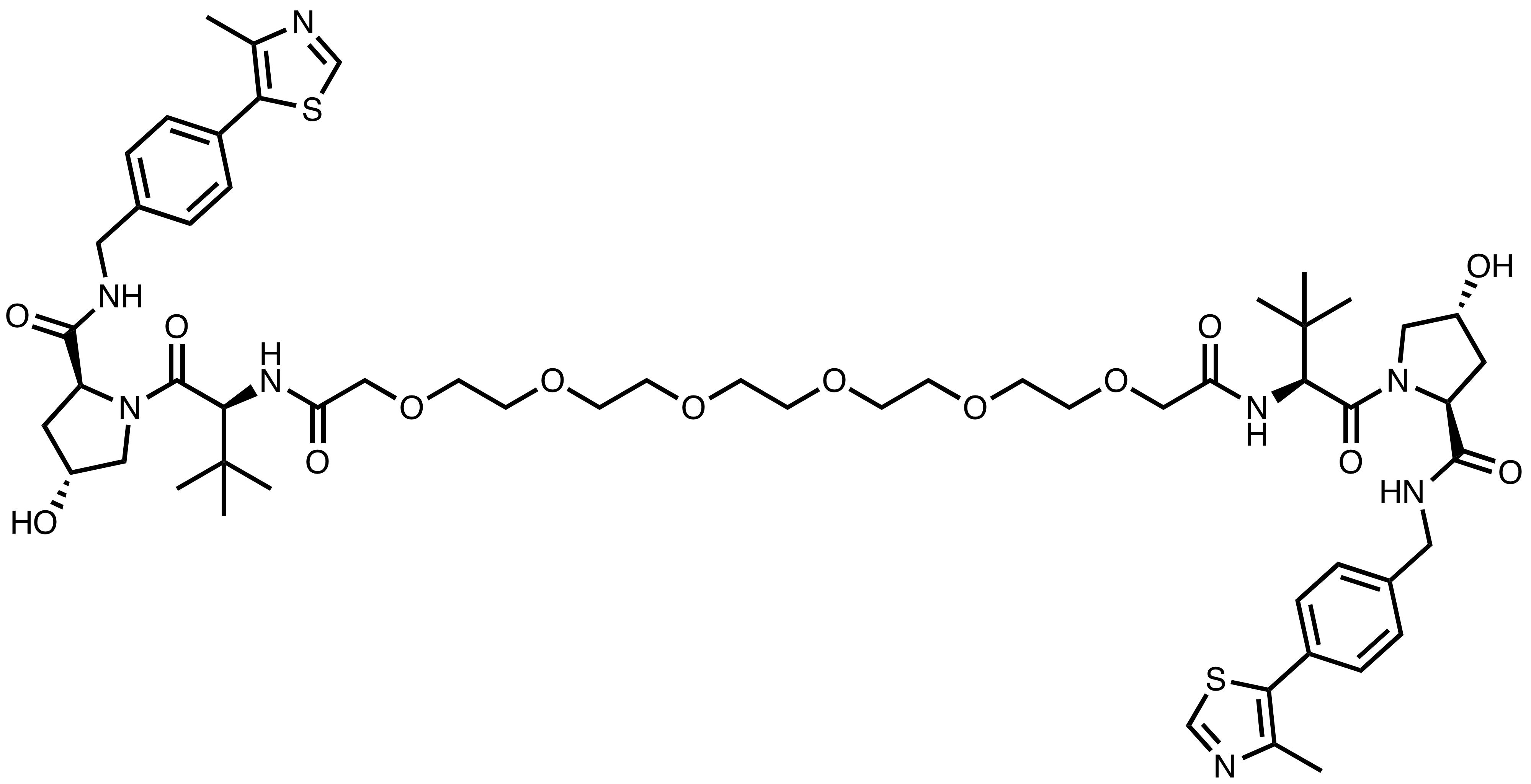
CM11
Protein Target(s) Name: E3 ubiquitin ligase VHL
Mechanism of Action: PROTAC degrader
Description: Homo-PROTAC dimerizer for self-degradation of the von Hippel-Lindau (VHL) protein. CM11 induces selective degradation of the long isoform of VHL (pVHL30) over the short isoform (pVHL19), and does so without triggering a hypoxic response in cells. CM11 also induces depletion of scaffold protein Cul2 in cells (1).
Chemical Name: N1,N20-bis((S)-1-((2S,4R)-4-hydroxy-2-((4-(4-methylthiazol-5-yl)benzyl)carbamoyl)pyrrolidin-1-yl)-3,3-dimethyl-1-oxobutan-2-yl)-3,6,9,12,15,18-hexaoxaicosanediamide
CAS Number: 2244684-49-7
In vitro pharmacology*: CM11 reduces pVHL30 protein levels in human cells: pVHL30 DC50 between 1-10 nM in HeLa cells (4 h); Dmax > 99%. CM11 induces time-dependent degradation of pVHL30, depleting 50% protein between 1-2 h of treatment at 1 uM in HeLa cells. CM11 (1 uM, 24 h) also induced 73% depletion of Cul2 in HeLa cells. Data from ref. (1)
*DC50: concentration in molar causing 50% reduction of protein level relative to vehicle control treatment.
Dmax: maximum reduction of protein level relative to vehicle control treatment.
Biophysical binding data: ITC Kd (pVHL30) = 25 nM; ITC Kd (pVHL19) = 11 nM; stoichiometry n = 0.6 (2:1 VHL:CM11 complex); cooperativity (alpha, relative to Kd for VH032) = 18. Data from ref. (1)
Proteome-wide selectivity: Unbiased and quantitative isobaric tagging MS proteomics confirmed no proteins other than VHL and Cul2 as substantially depleted upon treatment of HeLa cells with CM11 (1 uM for 10 h) amongst the 6,450 detected proteins that passed filtering criteria, compared to DMSO or VHL inhibitor VH032 treatment. Data from ref. (1)
In vivo PK data: not available
Crystal Structure: not available
Negative control: CMP98, CAS number: 2244684-50-0, available from Tocris
Primary References:
- Maniaci et al. (2017) Homo-PROTACs: Bivalent small-molecule dimerizers of the VHL E3 ubiquitin ligase to induce self-degradation. Nat. Commun. 8, 830. DOI: 10.1038/s41467-017-00954-1; PMID: 29018234
Articles that have used CM11:
- 2017 Maniaci Nat Commun http://dx.doi.org/10.1038/s41467-017-00954-1
- 2019 Steinebach Chem Commun http://dx.doi.org/10.1039/C8CC09541H
- 2019 Girardini Bioorg Med Chem https://doi.org/10.1016/j.bmc.2019.02.048
- 2020 Klein ACS Med Chem Lett https://doi.org/10.1021/acsmedchemlett.0c00265
- 2021 Castro RSC Med Chem https://doi.org/10.1039/D1MD00215E
- 2022 Gui ChemBioChem https://doi.org/10.1002/cbic.202200275
- 2022 Trapotsi ACS Chem Biol https://doi.org/10.1021/acschembio.2c00076
- 2023 Gui ACS Chem Biol https://doi.org/10.1021/acschembio.3c00199
- 2023 Gui ChemBioChem https://doi.org/10.1002/cbic.202300392
More information
More information on our chemical probes can be found from the Chemical Probes portal, and from commercial vendors such as Tocris Bio-Techne.
Related links
- Tocris Biotechne: CM 11 Cat. No. 6416
- Tocris Biotechne: CMP 98 Cat. No. 6417
- Chemical Probes.org: CM11
- MedChemExpress: CM11 Cat. No. HY-111593
- InvivoChem: CM11 Cat #: V17301
- DC chemicals: CM11 Cat. No.: DC11590
- TargetMol: Homo-PROTAC pVHL30 degrader 1 Catalog No. T13722
- Boc Sciences PROTAC: CM 11
- Boc Sciences PROTAC: CMP 98
- ProbeChem: CM11 Catalog No.: PC-60127
- Amadis Chemical: Homo-PROTAC pVHL30 degrader 1
- 2020s Top Probes | Chemical Probes